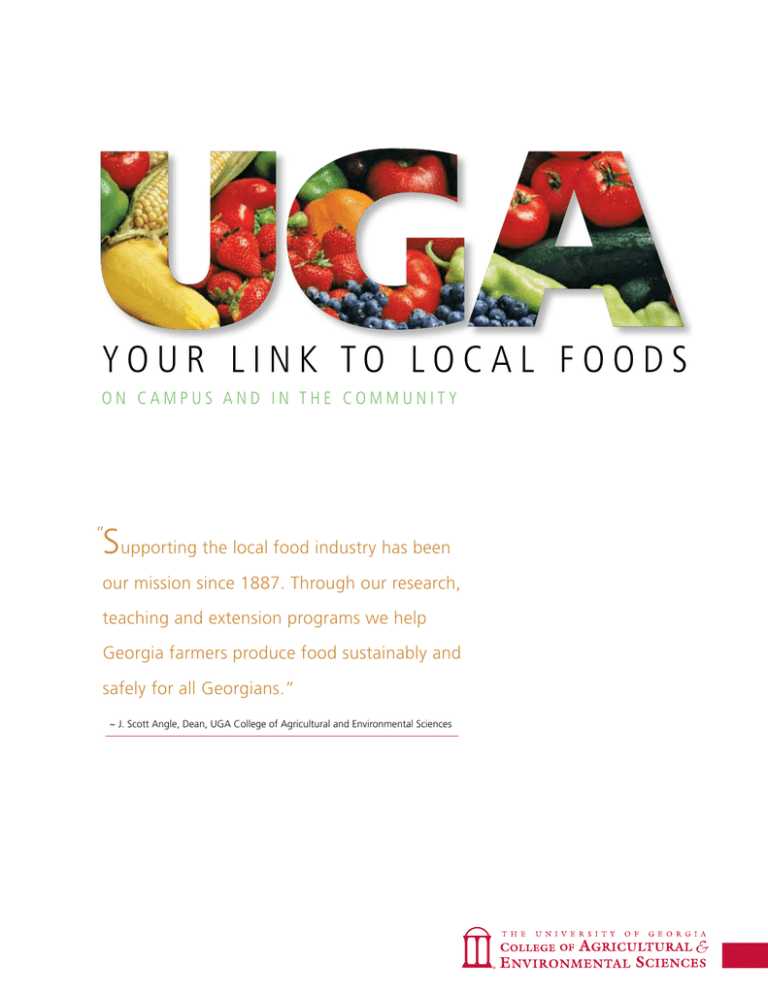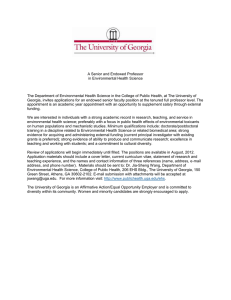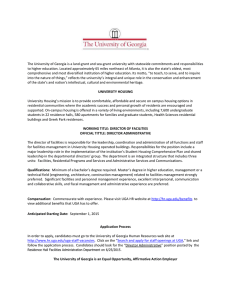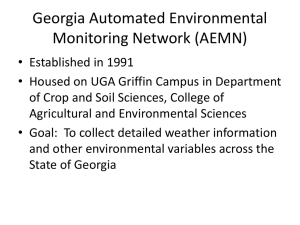Y o u r L i n k ... S
advertisement

Your Link to Local Foods on campus and in the community Supporting the local food industry has been ” our mission since 1887. Through our research, teaching and extension programs we help Georgia farmers produce food sustainably and safely for all Georgians.” ~ J. Scott Angle, Dean, UGA College of Agricultural and Environmental Sciences Your Link To Local Foods | The Facts Your Link To Local Foods | on campus Buying local: Healthy for Georgia’s economy and citizens I f Georgia farmers sold their produce directly to consumers rather than through distribution systems, they would make more money. According to a recent report from the University of Georgia College of Agricultural and Environmental Sciences Center for Agribusiness and Economic Development, Georgia farmers currently sell a only fraction of their products directly to consumers. “Looking at the quantity of foods directly marketed in Georgia, there is a tremendous opportunity there,” said Kent Wolfe, a CAES agricultural economist who worked on the study. Farmers get to keep a larger percentage of their food dollar when they sell directly to stores, restaurants or other consumers.” n Approximately 80 percent of the $20 billion Georgians spend on food comes from outside the state. average of 2.2 percent, direct sales would increase to more than $13 million. n Vegetables, fruits and nuts make up $2.85 billion of agriculture’s total economic impact on the state, and account for more than 25,000 jobs. n If Georgians produced all of the fruits and vegetables they consumed, it could provide a way to close the $780 million per year gap between statewide production and consumption. Simply closing the gap in one commodity – lettuce, for example – could mean an additional $83.6 million of direct revenue to local producers. n If each of the approximately 3.7 million households in the state spent $10 per week buying produce grown in Georgia, more than $1.9 billion would flow back into the state’s economy annually. n In 2007, Georgia vegetable and melon farmers sold $5 million worth of products directly to consumers by selling 1 percent of their total crop. According to the UGA study, if these farmers increased their direct- to-consumer sales to meet the national For more information, read the complete study at http://www.caed.uga.edu/ publications/2010/pdf/CR-10-03.pdf Related Publication: •Is Your Agribusiness Project Feasible? http://tinyurl.com/UGAAgribusiness If each of the approximately 3.7 million households in the state spent $10 per week buying produce grown in Georgia, more than $1.9 billion would flow back into the state’s economy annually. Local Food Systems Certificate Program T UGArden blossoms he University of Georgia brings gardening, fresh produce and nutritious food a little closer to the people who need it. health and community,” said David Berle, a horticulture professor with the UGA College of Agricultural and Environmental Sciences, who’s heading up the program. Starting in fall 2011, a certificate program in local food systems will give UGA undergraduates the opportunity to learn about the policies, production issues and cultural implications involved in producing food at the community level. The program seeks to build both urban and rural local food systems and teach people how to make healthy food choices and grow some of their own food, which can help reduce household food budgets. “With the slow-food movement, farm-toschool program and documentaries, people are making a connection between food, For more information on the certificate in local food systems, call 706-542-0771, e-mail dberle@uga.edu or visit ugalocalfoodsystems. uga.edu. UGA College of Agricultural and Environmental Sciences One program goal is to give students the tools to teach communities how to start their own gardens. A percentage of each harvest also goes to a local food bank. As of fall 2010, the garden had donated 500 pounds of produce to the Food Bank of Northeast Georgia. UGA dining halls source locally grown food U GA dining halls serve 30,000 meals a day. With a yearly budget of $10 million to purchase food products for students, Director of Food Services, Jeanne Fry wants to serve her customers local food as often as possible. UGA spends $1.5 million a year on fresh produce, a third of which is locally grown or locally processed. “Local” is defined by UGA’s food distributor as a product being grown or processed in Georgia or a state that borders Georgia. Under that terminology, “local” carrots may be grown in Texas but chopped into sticks in Atlanta. “We keep looking for opportunities and we keep trying [to source locally-grown food],” said Brooks Oliver, purchasing manager. “Our big push is the produce. Our definition may be different, but it gives us more opportunity.” UGA spends $1.5 million a year on fresh produce, a third of which is locally grown or locally processed. UGA works with Royal Foods to find local, seasonal items. For example, dining hall managers will request Gala apples from North Georgia instead of Red Delicious apples from Washington. Because of the enormous volume required to feed so many hungry students, contracting with local farmers is impractical, and all food must be sourced from USDA-certified farms, but UGA does currently receive several Georgia products, including: Food services buys in bulk to reduce transportation and then stores the product in a campus warehouse. This process has been in place since the 1970s. n All fresh eggs and poultry, sourced from local companies; nMilk from Mayfield Dairy in Braselton, Ga; nSoft-serv ice cream from Atlanta’s Greenwood Dairy; and nBread from Flowers, 80 percent of which is baked in Georgia. “We have 3,000 products from all over the world stored here,” he said. “Things you can’t buy local, like olives.” 2 U GA students started an on-campus vegetable garden in 2010. The UGArden plot on South Milledge Avenue is maintained by about 20 volunteers a week, and 200 students subscribe to its e-mail listserv. UGA College of Agricultural and Environmental Sciences 3 Your Link To Local Foods | in the community Your Link To Local Foods | in the community Schooling the community: UGA starts gardens in schools and communities across the state. Prisoners grow a garden of their own Inmates at the Thomas County Prison in Thomasville, Ga., grow their own food as part of a pilot project designed to teach them new skills and save the prison money. The prison was spending $1,000 or more buying produce each week before University of Georgia Cooperative Extension agent R.J. Byrne worked to help turn a portion of the prison’s land into a fruit and vegetable garden. Under Byrne’s guidance, inmates converted an acre of weeds into a plot teeming with corn, cucumbers, tomatoes, okra, beans and watermelons. Even with startup costs for seed, transplants and fertilizer, he estimates the prison will save several thousand dollars this year. Today, more than 200 students meet after school twice a week to learn about growing food. Finding hope in a garden A University of Georgia Cooperative Extension agent stepped in to help and built a garden of hope for residents at the Bridges of Hope residential alcohol and drug rehabilitation center. Johnny Whiddon, UGA Cooperative Extension agent in Brooks County, helps residents find food, skills and hope by helping to rebuild their small therapy garden, which started disappearing three years ago due to some hungry insects. For more information and free resources from UGA experts, visit www.caes.uga.edu/publications or www.ugaurbanag.com Read the full story at: http://georgiafaces.caes.uga.edu/?public=viewStory&pk_id=3980 Read the full story at: http://georgiafaces.caes.uga.edu/?public=viewStory&pk_id=3487 Community-grown in Henry County UGA Master Gardeners lend expertise Community gardens in Henry County give residents space to grow vegetables and provide food for the hungry. UGA Master Gardeners organized six gardens in the county where community members can request a plot to grow vegetables; two of those gardens produce food exclusively for the local food pantry. n Across the state, UGA-trained Master Gardeners work with communities and in schools to develop gardens. In 2009, 13,982 gardeners participated in community gardening projects. n Working with UGA Master Gardeners and through the Atlanta Urban Gardening Program, Fulton County Extension agent Bobby Wilson helped start 225 community gardens in Dekalb and Fulton counties. Food from gardens in the program help feed 300 homeless people at the Peachtree and Pine Shelter every month. Many of the community gardens also donate food to the Atlanta Community Food Bank through the Plant a Row for the Hungry program. To connect with Georgia Master Gardeners, check out the Georgia Master Gardener Program Facebook page. For more information about community gardens, call your local UGA Extension agent at 1-800-ASK-UGA1. School garden serves learning and lunch In Putnam County, both 4-H and a Junior Master Gardener Program support a growing school garden program that began in 2003 with a single garden. “We saw two things going on in our schools. “[First,] the students had little to no knowledge of agricultural activity in the state and no knowledge of how food was produced and brought to the table. [Second,] these kids lacked basic horticultural skills that I had at that age from hanging out with [my] parents and grandparents,” said Keith Fielder, UGA Cooperative Extension coordinator in Putnam County. Master Gardeners designed and built a U-shaped raised garden bed and, with the help of retired teachers, wrote classroom lesson plans. “We came into schools through 4-H and started teaching about the water cycle and 4 UGA College of Agricultural and Environmental Sciences delivering environmental programs on resource use,” he said. Today, more than 200 students meet after school twice a week to learn in several garden locations and greenhouses. The students grow just about every Georgia crop, except cotton and tobacco. “We talk about the importance of the commodities to Georgia’s economy,” Fielder said. “And we grow watermelons for the watermelon contest.” Fielder also incorporates healthy eating lessons into the program. Produce from the garden is given to the lunchroom to be included in the school menu. Read the full story at: http://georgiafaces. caes.uga.edu/?public=viewStory&pk_ id=3847 UGA College of Agricultural and Environmental Sciences 5 Your Link To Local Foods | in the community Your Link To Local Foods | in the community Giving farmers a market Home vegetable gardens F 3 resh produce takes on a whole new meaning when customers can meet the farmer who grows it. Across Georgia, communities are working to make that connection at local farmers markets. UGA county extension agents are helping make it possible. 1 Riverside Farmers Market Louise Estabrook, UGA extension agent in Fulton County, partnered with the city of Roswell to start the Riverside Farmers Market, which she now manages. One hundred percent of the more than 50 vendors at the market sell only Georgia products. The market, which now accepts Electronic Benefits Transfer or food stamps, just completed its third successful season. It served more than 26,000 patrons during the 2010 season. Besides the farmers selling produce, meats, honey, flowers, nursery plants and eggs, there are valued-added vendors who sell baked goods, salsa and other prepared foods. The market hosts a knife-sharpener, too. There is live music, a children’s event tent, an “ask-the-MasterGardener” booth and a chef demonstration with market tours. And Estabrook has started contests, including an apple pie bake-off, watermelon eating contest and a zucchini derby. She provided the zucchini, wheels and stickers, and children built the race-ready vegetable vehicles. Henry County Farmers Market 1 “People are looking 2 UGA College of Agricultural and Environmental Sciences U “Planning is very important when starting a new garden,” Westerfield said. “Consider how much time you have and what you want out of your garden. Then, set some goals and get to work.” Some steps to consider as a new gardener: 1. Select a good location for the garden. A family of four can get a wealth of food from a 20x30-foot garden. Be sure to get a soil test from your local county extension office and follow through with any recommendations. When planning to install a new garden, consider adding an extra row and donating the surplus to a local food bank. 2. Become knowledgeable about which varieties to plant, when to plant them and how. Base planting dates on recommended temperatures. 3. After planning and planting, be sure to watch for moisture. Westerfield recommends installing some type of irrigation system.Vegetables that are tough or bitter signal problems with the watering cycle. 4. Harvest regularly. Tomatoes, beans and okra need to be harvested often to signal the plant to continue production. Picking vegetables while they are immature is best for taste, too. 5. Once vegetables have played out, move on. Either dig up the entire plant or till it into the soil. Leaving plants in the field invites disease and insect infestations that may last until the next year. Georgia’s climate allows for multiple plantings each year. Most gardens can produce two spring crops and two winter crops in a single year if properly planned and cared for. 4 Hawkinsville Farmers Market 3 Athens Farmers Market 6 for home grown, local foods. The problem is not that we don’t have the demand, it is having enough produce.” ~Ronnie Barentine Pulaski County Extension Agent 2 The Athens Farmers Market is a produceronly market, offering fresh produce from local growers to a community with a hunger for local dishes. Amanda Tedrow, Athens-Clarke County UGA extension agent, helped organize and runs the local market. Tedrow also organizes cooking demonstrations. Master Gardeners are on-hand to answer questions ranging from composting to canning. When the market opened in Henry County in 2008, extension agent Frank Hancock didn’t know what to expect. When he opened the gate the first day there were 50 people waiting to get in. The market opens on Thursday afternoons and only sells produce from within a 50-mile radius under the premise that it is locally grown and freshly picked. Last year, 63,000 people shopped the market sometimes buying produce from as few as 10 vendors. niversity of Georgia Cooperative Extension agents are available to help Georgians produce their own crops at home. Bob Westerfield is the state’s extension consumer horticulturist and a resource for home vegetable gardeners. Every year, he reaches thousands of people through news articles, publications and programming. His overarching message: Create a balance between what you want and what is realistic. Pulaski County extension agent Ronnie Barentine hosts a downtown market on Saturdays in the summer, a trend that began in 2004. Before the Hawkinsville Market opened for local growers, farmers would travel to Cordele or Macon to sell their goods. Plans are in the works to open a daily market soon. “People are looking for home grown, local foods, said Barentine. “ The problem is not that we don’t have the demand, it is having enough produce.” 4 For more information on Georgia farmers markets, visit www.pickyourown.org/ GAfarmersmarkets.htm or www.localharvest.org. For more information about home vegetable gardening contact your local county Extension office by calling 1-800-ASK -UGA1 Related Publications: •Vegetable Garden Calendar http://tinyurl.com/UGAVegCalendar Get planting date recommendations based on long-term average dates of the last killing frost in the spring and first killing frost in the fall. •When to Harvest Vegetables http://tinyurl.com/UGAHarvest Determine the proper stage of maturity for harvesting many vegetables commonly grown in Georgia. •Home Gardening http://tinyurl.com/UGAGardening Everything you need to know about growing a successful home vegetable or herb garden. Preserve garden bounty by canning A n increase in home gardening has created a rise in people wanting to preserve its bounty through canning. However, there are risks associated with canning foods. Specific preserving methods must be used to keep the food safe when stored at room temperatures. Food can spoil and make you sick if canning directions are not followed exactly. Local UGA Cooperative Extension offices can share resources with people who want to can foods at home. County offices can also direct citizens to community canneries that may be located nearby if they want to process large quantities of food at one time. The Food Science Extension department at the University of Georgia provides process schedules for the equipment used in the canneries. Processing schedules at home will be different than those used in commercial canneries. Community canneries are located in Appling, Berrien, Brooks, Calhoun, Colquitt, Emanuel, Early, Fannin, Franklin, Gilmer, Habersham, Houston, Irwin, Lanier, McDuffie, Murray, Pickens, Seminole, Stephens, Tattnall, Treutlen, Tift, Turner, Union and White counties. Contact your local UGA Cooperative Extension office with canning questions at 1-800-ASK-UGA1. Learn how to preserve food at home using current research-based recommendations from The National Center for Home Food Preservation at: www.uga.edu/nchfp/ UGA College of Agricultural and Environmental Sciences 7 Your Link To Local Foods | Research UGA research: Developing better plants for Georgia U niversity researchers are constantly developing new plant varieties to increase taste and yield while decreasing disease and insect threats. Blue Suede Orange Bulldog For years, University of Georgia plant breeder Scott NeSmith has created new blueberry varieties for the commercial market. Now, he has bred one just for home gardeners. Heading to a local pumpkin patch to pick the season’s best is a fun fall activity. Thanks to University of Georgia researchers, a better, Georgia-specific pumpkin is now available. Blue Suede is a Southern highbush blueberry for edible home landscapes, said Nesmith, a horticulturist with the UGA College of Agricultural and Environmental Sciences. The plant produces flavorful, large, light-blue berries. “Most of the pumpkins traditionally grown commercially in Georgia are highly susceptible to viruses and other foliar diseases,” said George Boyhan, a horticulturist with the UGA College of Agricultural and Environmental Sciences. Blue Suede is the first UGA edible ornamental blueberry release, but it won’t be the last, Nesmith said. There are plans to breed and release blueberry plants that produce a variety of different traits. Even with an aggressive program to control tiny insects called aphids, aphidtransmitted viruses can quickly devastate the crop, he said, at times resulting in complete loss.Orange Bulldog is an improved variety that has greater levels of resistance to viruses than conventional pumpkins. Boyhan is now working to develop a variety with more uniformity in shape and color but with the same disease resistance as Orange Bulldog. “We are looking at one plant that produces a berry that turns yellow, orange and then black,” he said. “They will all be very edible, very sweet and attractive in a landscape.” Read the full story at: http://georgiafaces. caes.uga.edu/?public=viewStory&pk_ id=3937 Read the full story at: http://georgiafaces. caes.uga.edu/?public=viewStory&PK_ ID=3582 Find your local market G eorgia MarketMaker is UGA’s online interactive mapping system that connects consumers with markets and businesses that make agricultural products in Georgia. Georgia MarketMaker allows producers to list their businesses, products and links to their websites in a searchable database. And, there’s no charge. The website also provides producers with pricing information, consumer demographics and contact information for potential processors, wholesalers and retailers of specialty food products. n Last year, the site averaged 75,000 web hits, or page views, per month. n The site features 35,000 Georgia food-related businesses and more than 450 producers/farmers. n Consumers can search for Georgia food products based on different characteristics, such as gluten-free. n Find local pick-your-own farms, specialty products sold by local vendors or a list of the 139 farmers markets in the state. Visit Georgia MarketMaker at www. marketmaker.uga.edu. Funded by the University of Georgia College of Agricultural and Environmental Sciences Office of Environmental Sciences and the UGA Center for Urban Agriculture. 8 UGA College of Agricultural and Environmental Sciences






